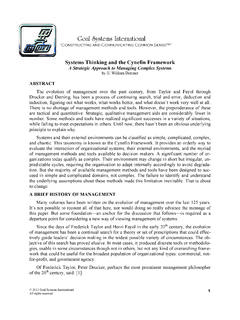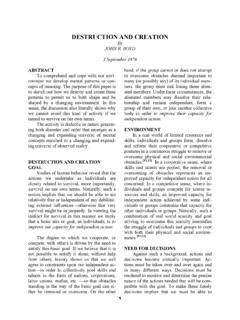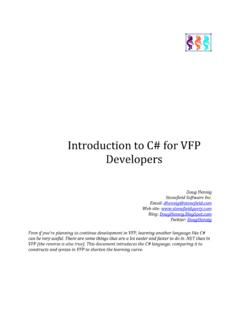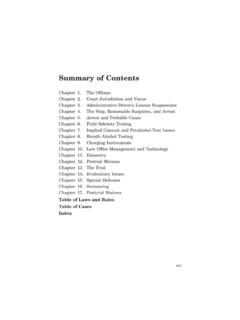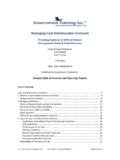Transcription of Constraint Management - Goal Sys
1 In 1995, the American Society for Quality began providing professional certification in quality Management the Certified Quality Manager (CQM) through closed-book testing on a pre-determined body of knowl- edge. That body of knowledge now includes the Theory of constraints (TOC). To aid prospective quality professionals in preparing for the CQM examina- tion, Quality America, Inc. (Phoenix, AZ) prepared a comprehensive book on the CQM body of knowledge called The Complete Guide to the CQM, written by Thomas Pyzdek and originally published in 1996. The following paper is a chapter in the updated 2000 edition of The CQM Guide. This paper is copyrighted material. Quality America, 2000. Reprinted with permission. Constraint Management by H. William Dettmer INTRODUCTION. As we enter the twenty-first century, quality has come to encompass much more than just product or process conformance.
2 More and more, quality is in the eye of the beholder: the customer. And with the widespread acceptance of higher product and process quality standards as a way of life among commer- cial companies, not-for-profit organizations, and government agencies, the playing field tends to level out to some degree. For the customer, this means that it can be more difficult to differentiate between the product quality offered by competitors. When this happens, it's only natural that a customer's atten- tion should shift to another characteristic of the interaction with a supplier: quality of service. ( Sure, they deliver a quality product, but their service leaves a lot to be desired. ). In many cases, the difference between winning and losing a customer's business (or continued loyalty) resides in the quality of the interaction between customer and supplier. In other words, service can be as important an element in customer satisfaction as product quality.
3 Once managers venture beyond product and process conformance (or quality), they move up from process improvement to system-level improvement. More than ever before, quality managers are finding themselves in need of system-level tools in order to sustain the relevance in business success they've fought so hard to achieve. One such system-level tool is Constraint manage- ment. Constraint Management doesn't assume that product and process quality have already been taken care of. Rather, it acknowledges that quality is but one important element in the business equation. Constraint Management seeks to help managers at all levels of an organization maintain proper focus on the factors that are most critical to overall success: system constraints . In some Quality America, Inc., 2000. All rights reserved. Reprinted with permission. 1. systems, these might be quality-related. In other systems, they may extend well beyond the traditional territory of quality.
4 Have you ever heard the saying, You can't put ten pounds of sand in a five-pound bag? How about, I'm trying to juggle too many priorities at once.. If you've heard (or said) either of these things, you have some sense of the stress that constraints impose on everyone. In many cases, the challenge appears to be not enough time. But the characteristics of time are immutable. Excluding considerations of the theory of relativity, time passes at a constant, familiar, well-defined rate though sometimes it seems to positively fly, while other times it drags interminably! So the causes of stress must really be something else. This something else is often some kind of Constraint . Sometimes our constraints aren't merely physical ( , lack of space, not enough resources, etc.). In many cases they're policies: the laws, regulations, rules, or procedures that determine what we can or can't do.
5 Even the way we think can be a Constraint to ourselves and our organizations. Who hasn't heard it said, That's the way we do things around here ? Or, alternatively, That's not the way we do things around here. What you're hearing is the verbalization of a policy, possibly unwritten, but accepted as traditional practice nonetheless. When a policy of any kind inhibits what we need (or want) to accomplish, it, too, constitutes a Constraint . The practice of Constraint Management tacitly recognizes that constraints limit what we can do in any circumstance, and it provides the vehicle to under- stand why this happens and what can be done about the constraints we face. Constraint Management is an outgrowth of the Theory of constraints (TOC), a set of principles and concepts introduced by Eliyahu M. Goldratt, an Israeli physicist, in the 1980s in a book entitled The Goal (Goldratt, 1986).
6 These principles and concepts are a blend of both existing and new ideas. The new ideas build upon older ones to produce a robust, holistic approach to understanding and managing complex systems. To extend the theoretical principles and concepts into application, Goldratt developed three classes of tools, which will be described in more detail later. For now, the important point to remember is that TOC, and Constraint Management as a whole, constitutes a systems Management methodology. THE SYSTEMS APPROACH. What do we mean by systems Management ? Throughout the twentieth century, Management thought was largely activity-oriented. In the early 1900s, Frederick Taylor's scientific Management (Taylor, 1947) focused on dividing and subdividing work into discrete tasks or activities that could be closely moni- tored, measured, and tweaked to produce the most efficient performance from Quality America, Inc.
7 , 2000. All rights reserved. Reprinted with permission. 2. each activity. By the second half of the century, the focus had enlarged some- what to encompass managing processes composed of several activities. At some level, these processes could become quite large and complex, such as a produc- tion process, a purchasing process, or a marketing and sales process. One way of dealing with complexity is to compartmentalize it to cut it up into manageable bites. Organizations typically do that by creating functional departments. Each department is responsible for some function that consti- tutes a part of the whole system. One could even say that these parts are actually individual processes. This is an orderly way to come to grips with the issue of complexity. Throughout the 1980s and early 1990s, the meteoric rise of the quality movement reinforced the idea that success lay in continuous refinement of processes.
8 The ultimate objective became six sigma, a level of defect-free performance unheard of twenty years before. Unquestionably, both commercial and non-commercial organizations needed this focus. Poor product quality (which is usually a result of faulty process quality) can bring down an organiza- tion faster than just about anything else. But many companies, despite herculean efforts and the expenditure of significant amounts of money, were disappointed to find that their payback wasn't what they expected it to be. The idea that if you build a better mousetrap, the world will beat a path to your door worked exceptionally well for the companies whose overriding Constraint had been product quality. Yet for other companies, the strategy seemed to be somewhat underwhelming. Despite the admonition to consider your internal customer, many departments still behave as if they're in a silo by themselves.
9 They pay lip service to the idea, but for a variety of reasons they don't practice it very well. Their focus remains inward, on individual measures of performance and efficiency. Most efforts are spent improving the links of the supply chain, with little effort devoted to the linkages, or interfaces between links, and the opera- tion of the chain as a whole. Systems Thinking What these companies failed to appreciate was that a higher level of thinking was needed: systems thinking. Once the quality of individual pro- cesses is put reasonably well into line, other factors emerge to warrant atten- tion. Consider the analogy of a football team. Major professional sports spend a lot of time and money on process improvement, even though they probably don't look at it that way. A team owner can spend millions on a contract for a star quarterback. By applying natural talent, they expect to improve the passing process.
10 But in many Quality America, Inc., 2000. All rights reserved. Reprinted with permission. 3. cases, the touchdowns don't appear, despite the huge sums spent on star quarterbacks. At some point in the process failure mode effects analysis, the coaches discover it's impossible for this highly-valued quarterback to complete passes from flat on his back. They find that the offensive line needs shoring up. Or a good blocking back is needed, or a better game plan, or any number of other factors. The point is that any organization, like a football team, succeeds or fails as a complete system, not as a collection of isolated, independent parts or processes. In the same way that a motion picture clip tells us much more about a situation than an instantaneous snapshot, systems thinking gives us a clearer picture of the whole organizational dynamic. In The Fifth Discipline (Senge, 1990), Peter Senge proposes that the only sustainable competitive advantage comes from transforming a company into a learning organization.


